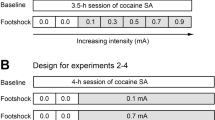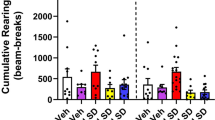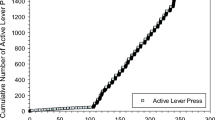Abstract
SEVERAL investigators have attempted to find a safe but reliable means of determining whether a new drug will produce hallucinations in man1–4. Smythies et al. have found that rats show a characteristic “hallucinogenic profile” on various standard behavioural tasks. We ran rats on two of these tasks—responding on a differential reinforcement of low rate (DRL) schedule and discriminated Sidman avoidance—after administration of l-Δ1-tetrahydrocannabinol (THC), a known hallucinogen for man5–7. We hoped to find out whether the rats would display the hallucinogenic behavioural profile; and by using the same dose range for each task, to find the dose–effect relationship.
This is a preview of subscription content, access via your institution
Access options
Subscribe to this journal
Receive 51 print issues and online access
$199.00 per year
only $3.90 per issue
Buy this article
- Purchase on Springer Link
- Instant access to full article PDF
Prices may be subject to local taxes which are calculated during checkout
Similar content being viewed by others
References
Witt, P. N., Die Wirkung von Substanzen auf den Netzbau der Spinne als Biologischer Test (Springer, Berlin, 1956).
Abramson, H. A., Gettner, H. H., Hewitt, M. P., and Dean, G., J. Psychol., 52, 445 (1961).
Schneider, C. W., and Chenoweth, M. B., Nature, 225, 1262 (1970).
Smythies, J. R., Johnston, V. S., and Bradley, R. J., Brit. J. Psychiat., 115, 55 (1969).
Mechoulam, R., and Gaoni, Y., Fortschr. Chem. Organ. Natur-stoffe (edit. by Zeehmeister, L.), 25, 175 (1967).
Isbell, H., Gorodetzsky, C. W., Jasinski, D., Claussen, U., and Korte, F., Psychopharmacologia, 11, 184 (1967).
Hollister, L., Richards, R., and Gillespie, H., Clin. Pharmacol. Exp. Ther., 9, 6 (1968).
Smythies, J. R., Johnston, V. S., and Bradley, R. J., Nature, 216, 196 (1697).
Zimmerman, J., and Schuster, C. R., J. Exp. Anal. Behav., 5, 497 (1962).
Sidman, M., J. Comp. Physiol Psychol., 48, 444 (1955).
Bovet, D., and Gatti, G. L., in Pharmacology of Conditioning, Learning and Retention, 75 (New York, 1965).
Smythies, J. R., Johnston, V. S., Bradley, R. J., Bennington, F., Morin, R. D., and Clark, L. C., Psychopharmacologia, 10, 379 (1967).
Appel, J. B., Psychopharmacology: A Review of Progress 1957–67, (edit. by Efran, D. H.), 1211 (Public Health Service, 1967).
Author information
Authors and Affiliations
Rights and permissions
About this article
Cite this article
WEBSTER, C., WILLINSKY, M., HERRING, B. et al. Effects of l-Δ1-Tetrahydrocannabinol on Temporally Spaced Responding and Discriminated Sidman Avoidance Behaviour in Rats. Nature 232, 498–501 (1971). https://doi.org/10.1038/232498a0
Received:
Revised:
Published:
Issue Date:
DOI: https://doi.org/10.1038/232498a0
This article is cited by
-
Hashish smoke interfers with Sidman avoidance in mice
Experientia (1979)
-
Cannabis interferes with nest-building behavior in mice
Psychopharmacology (1978)
-
Screening hallucinogenic drugs
Psychopharmacology (1978)
-
Screening hallucinogenic drugs: Systematic study of three behavioral tests
Psychopharmacologia (1975)
-
Effects of repeated doses of l-?8-trans-tetrahydrocannabinol on schedule-controlled temporally-spaced responding of rats
Psychopharmacologia (1974)
Comments
By submitting a comment you agree to abide by our Terms and Community Guidelines. If you find something abusive or that does not comply with our terms or guidelines please flag it as inappropriate.



